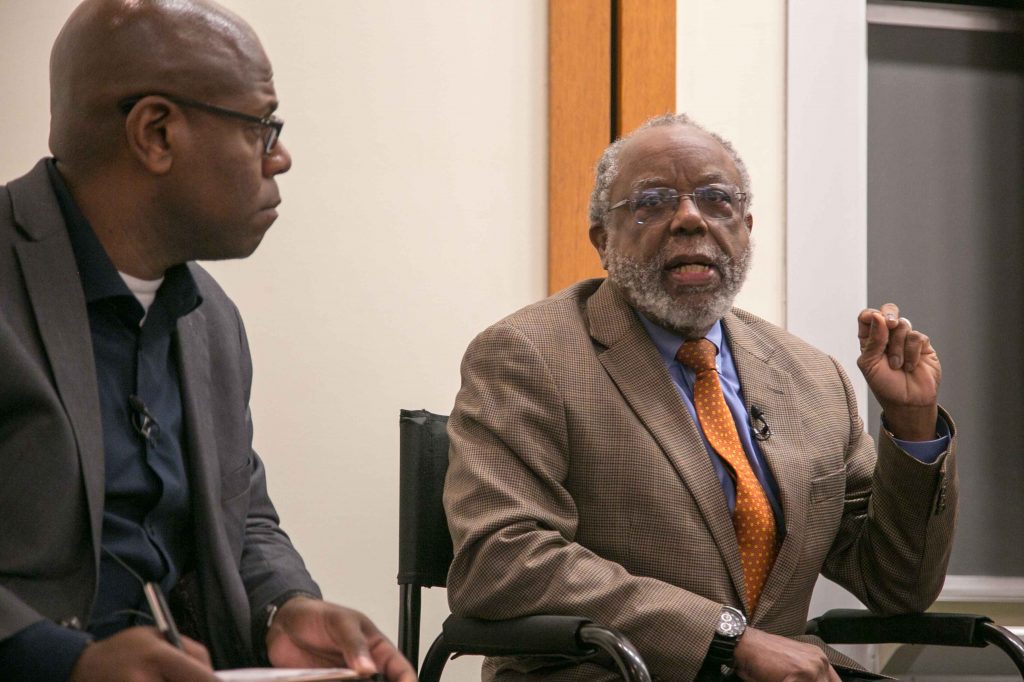A panel comprising developers, educators, and policy makers convened October 16 to discuss the role that urban planning can play in creating diverse, inclusive communities—and of their failure to do so in Boston.
Sean Fontes, executive counsel at the Rhode Island Department of Labor and Training, moderated the Rappaport Center for Law and Public Policy event. He began by quoting a 2017 Boston Globe Spotlight article, “A Brand New Boston, Even Whiter Than the Old,” that revealed a startling number and then restated it: “That was no typo: the median net worth of Black Bostonians really is $8.” Fontes pointed to the story as proof that racism and inequality have continued to subvert the city’s African Americans long since the so-called fall of segregation in the 1970s.
Fontes said the recent evidence lies in the city’s shiniest new gem, the Seaport, with its premium corporations, high-end bars and restaurants, and luxury apartments. The Globe wrote that this is the very site city planners of 20 years ago thought $18 billion could transform into a bustling neighborhood for all of its citizens. What it created instead, the newspaper reported, “is one of the whitest neighborhoods in Boston.”
Among those joining Fontes in the discussion was panelist Harley Etienne, associate professor of urban and regional planning at the University of Michigan. He observed that minorities and impoverished Bostonians are being pushed outside of Boston for a variety of reasons.
One of them is politics. It is up to the public, Etienne said, to make officials accountable for creating exclusionary zoning and disparate impact laws. Another is the city’s failure to retain the minority graduates of its universities. “Let’s promote their livelihoods here, instead of creating a get-the-heck-out-of-here mentality,” Etienne advised. He also took aim at the real estate brokers in the city. “Two to three percent of all Realtors in Boston are black or Latino. This needs to change,” he said.
Northeastern Professor Ted Landsmark (the same Ted Landsmark depicted in the Pulitzer Prize-winning photo “The Sailing of Old Glory” that epitomized Boston’s racial struggles in the 1970s), was the city of Boston’s voice on the panel. A board member of the Boston Planning and Development Agency, Landsmark argued that the city was extremely short of funds when it was considering what to do with the rundown Seaport neighborhood; it didn’t even have the money for social service programs throughout the city.
A solution was to “create a revenue base” by investing heavily in the area to attract large corporations and developers to build there. The city would be able to generate funds, could avoid spending on social services (like parks and schools) for them, and then use the funds to pay for social services where they were needed.
In this aspect, the plan worked, said Landsmark, who is also director of the Kitty and Michael Dukakis Center for Urban and Regional Policy at Northeastern. “The city created a money machine…but all decisions have consequences. [At least] it was required that private developers in the area set money aside for a separate fund to create…more units than they would have otherwise.”
As a real estate developer, Kathleen MacNeil, principal for MDA Partners LLC, a joint venture of Millennium Partners and MDA, pointed to problems within the private sector that create these all-white neighborhoods. “This was a project all about financial gain and nothing else. Today, we are developing inclusion, but more action must be taken than just writing checks for affordable housing,” she said.
Referring to Etienne’s Realtor statistic, she added, “This is a relation-based industry. You get in the business because your dad owns land in Boston and because your grandfather was a land developer. That doesn’t exist with minorities.”

Angie Liou, executive director of Boston’s Asian Community Development Corporation, said that for her constituents the barriers to participation in local politics, such as zoning board meetings, were “language limitations and lack of income.” The recent wave of gentrification is another destabilizing factor that is affecting not just blacks and Latinos, but Asians as well, she noted.
The panel concluded with a call-to-action by Landsmark. “Let’s integrate our minorities better. Schools need to foster a nurturing environment where these groups can envision themselves succeeding in society. You [pointing to the students] are an asset to your neighbors. You need to make yourselves available so that these young people can get to where you are now. That’s how you can begin to see change,” he said.


